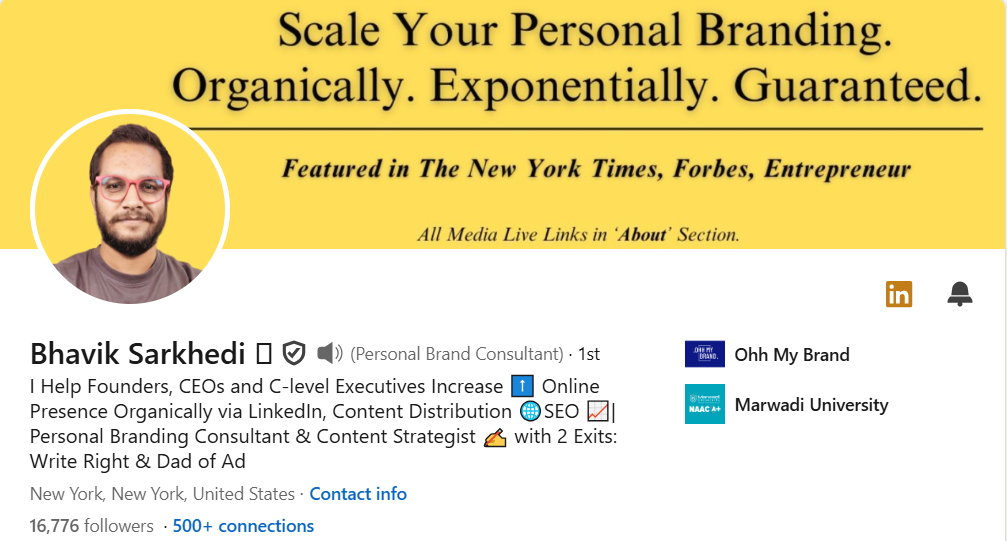Build your personal brand by following these five key steps:
Define your unique value proposition to highlight what sets you apart.
Create a consistent online presence across all digital platforms.
- Engage with your audience through regular and meaningful interactions.
Network effectively both online and offline to build valuable connections.
Continuously learn and adapt to stay relevant and enhance your brand.
These personal branding strategies will help you achieve effective personal branding and online reputation management, ensuring you are always in control of branding yourself.
How do you make a lasting impression in a world where first impressions are often made online? Building a personal brand is essential for standing out and showcasing what makes you unique. Personal branding is more than just a polished LinkedIn profile or a catchy bio; it’s the distinctive blend of your skills, experiences, and personality presented to the world.
A well-crafted personal brand can unlock new career opportunities, boost your credibility, and position you as an authority in your field. For instance, Tim Ferriss has built his personal brand around productivity and lifestyle design, allowing him to attract a dedicated following and numerous business ventures.
In a competitive environment, a strong personal brand is your edge. It communicates your unique value proposition, making it easier for potential employers, clients, and collaborators to see what sets you apart. By defining your unique attributes, you help others understand and remember your contributions.
This blog will explore five proven strategies to build your personal brand: defining your unique value proposition, creating a consistent online presence, engaging with your audience, networking effectively, and continuously learning and adapting. These personal branding strategies are designed to help you achieve effective personal branding and ensure robust online reputation management, ultimately making branding yourself a rewarding and impactful process.
1. Define Your Unique Value Proposition
Defining your unique value proposition (UVP) is the cornerstone of effective personal branding. Your UVP is a concise statement that communicates the unique benefits and value you offer to your target audience. It highlights the specific problem you solve, the advantages you provide, and why you are superior to your competitors. Here’s how to craft a compelling UVP to build your personal brand:
Understand Your Target Audience
The foundation of a compelling UVP lies in a deep understanding of your target audience. Segment your market and identify the specific group of people you aim to serve. Dive into their demographics, psychographics, and behavior patterns to grasp their needs, preferences, and decision-making processes. Use surveys, focus groups, and market research to gather insights. This granular understanding allows you to craft a UVP that resonates personally with your audience, addressing their unique desires and concerns.
Recognize the Pain Points You Solve
A critical aspect of your UVP is its ability to address a specific pain point or challenge your audience faces. Conduct thorough research to pinpoint these challenges. Are your clients looking to save time, reduce costs, or improve efficiency? Articulate how your skills and expertise provide solutions to these pain points, directly connecting your offerings to the needs of your audience.
Pinpoint the Benefits You Offer
While the features of your skills or services are important, the benefits they bring to your audience are what truly matter. Translate features into benefits by asking, “So what?” after each feature to delve into its impact on the customer. For example, a feature might be “24/7 availability,” but the benefit is peace of mind and support whenever needed. Clearly communicating these benefits helps potential clients visualize the positive impact of working with you.
Articulate What Makes You the Best Solution
Having a good solution isn’t enough; you need to communicate why your solution is the best choice. Highlight your unique strengths and differentiators. This could be proprietary knowledge, an innovative approach, or exceptional service standards. This differentiation should be clearly articulated in your UVP, positioning you as the preferred choice and instilling confidence in potential clients that choosing you is the best decision they can make.
Crafting Your UVP Statement
Combine these elements into a concise and compelling statement. Your UVP should be specific, pain-focused, and exclusive. It should clearly state what you offer, how it benefits your target audience, and what makes you unique. For instance, “I help busy professionals save time and reduce stress by providing comprehensive and efficient virtual assistant services, ensuring they can focus on what truly matters.”
By defining your unique value proposition effectively, you set the stage for effective personal branding and ensure robust online reputation management. This clarity in branding yourself will make it easier for your target audience to understand and appreciate the unique value you bring to the table.
2. Create a Consistent Online Presence
Creating a consistent online presence is fundamental to build your personal brand. Consistency in your online activities helps establish trust, recognition, and reliability, which are crucial for effective personal branding. Here are some strategies to help you achieve a consistent and compelling online presence:
Optimize Your Social Media Profiles
Ensure all your social media profiles reflect your personal brand’s identity. This includes using a professional and high-quality profile photo and cover image, which should be visually appealing and represent your brand accurately. Write a clear and engaging bio that highlights your skills, achievements, and values. Use keywords strategically in your profiles to improve visibility and discoverability on platforms like LinkedIn, Twitter, and Instagram.
Build a Professional Website or Blog
A professional website or blog serves as your digital headquarters. It should be user-friendly, responsive, and fast-loading. Ensure your website is optimized for search engines (SEO) by using relevant keywords, meta tags, and descriptions. Regularly update your website with valuable content to attract visitors and improve search engine rankings. High-quality visuals and a consistent aesthetic are important to maintain a professional image and reinforce your brand’s identity.
Leverage Content Marketing
Content marketing is a powerful tool for boosting your online presence. Develop a content strategy that includes blog posts, articles, infographics, and videos relevant to your industry. Share valuable content that addresses the needs and interests of your target audience. Consistent content creation helps establish you as an authority in your field and encourages audience engagement and sharing.
Engage with Your Audience on Social Media
Active engagement on social media platforms is essential. Post regularly and interact with your followers by responding to comments, messages, and reviews. Participation in conversations and sharing user-generated content can significantly enhance your visibility and foster a sense of community around your brand. Consistency in posting and engagement helps keep your audience connected and interested in your brand.
Utilize Email Marketing
Email marketing reinforces brand recognition and keeps your audience engaged. Send regular newsletters with updates, valuable content, and promotions to your subscribers. Ensure your emails reflect your brand’s identity and messaging consistently. Email marketing helps maintain a direct line of communication with your audience, keeping your brand top-of-mind.
Monitor and Manage Your Online Reputation
Effective online reputation management is crucial for maintaining a positive brand image. Regularly monitor what is being said about you online and address any negative feedback promptly and professionally. Use tools to track mentions and reviews across various platforms. Responding to reviews and engaging with your audience demonstrates your commitment to customer satisfaction and helps build trust.
By implementing these strategies, you can build a consistent and effective online presence that supports your personal branding efforts, enhances your credibility, and ensures robust online reputation management. This consistency in branding yourself will help you stand out and achieve your professional goals.
3. Engage with Your Audience
Engaging with your audience is a crucial aspect of building your personal brand. Active engagement not only strengthens relationships with your audience but also enhances your credibility and visibility. Here are some effective personal branding strategies to engage with your audience:
Connect with Your Target Audience
To effectively connect with your audience, understand who they are and what they care about. Identify your target audience’s demographics, interests, and preferences. Use this information to create content that resonates with them. Personalizing your approach helps build a deeper connection and demonstrates that you value their interests and opinions.
Create Regular and Valuable Content
Consistently creating valuable content is key to maintaining audience engagement. Share content that addresses their needs, interests, and pain points. This can include blog posts, videos, podcasts, and social media updates. Regular content creation not only keeps your audience engaged but also establishes you as an authority in your field, contributing to effective personal branding.
Utilize Email Newsletters
Email newsletters are an effective way to maintain regular contact with your audience. Share updates, valuable content, and exclusive offers through your newsletters. Ensure your emails are well-crafted, visually appealing, and provide clear value to the recipients. Regular newsletters keep your audience informed and engaged, helping to build loyalty and trust.
Respond to Comments and Feedback
Engagement is a two-way street. Actively respond to comments and feedback on your content and social media posts. Whether the feedback is positive or negative, addressing it promptly shows that you value your audience’s input. This interaction helps build a sense of community and trust, enhancing your online reputation management efforts.
Encourage User-Generated Content
Encourage your audience to create and share content related to your brand. This can include reviews, testimonials, or social media posts. User-generated content not only provides social proof but also fosters a sense of community and involvement. Share and acknowledge this content to show appreciation for your audience’s contributions.
Host Webinars and Live Q&A Sessions
Hosting webinars and live Q&A sessions allows you to engage with your audience in real-time. These sessions provide an opportunity to share your expertise, answer questions, and interact directly with your audience. This live interaction can significantly enhance your connection with your audience and demonstrate your commitment to helping them.
Leverage Social Media Engagement Tools
Use social media engagement tools to track and manage your interactions. Tools like Hootsuite, Buffer, and Sprout Social can help you schedule posts, respond to comments, and analyze engagement metrics. These tools ensure you stay on top of your engagement efforts and maintain a consistent presence.
By implementing these strategies, you can effectively engage with your audience, strengthening your personal brand and enhancing your credibility. Consistent and meaningful engagement is key to branding yourself successfully and ensuring robust online reputation management.
4. Network Effectively
Character illustration of business people with connection icons[/caption]
Networking is a vital component of building your personal brand. It helps create valuable connections, fosters professional growth, and enhances visibility in your industry. Here are some strategies to network effectively and build your personal brand:
Importance of Networking
Networking plays a crucial role in personal branding by connecting you with like-minded professionals and industry influencers. It helps you establish and nurture relationships that can lead to new opportunities, collaborations, and career advancements. A strong network can support your personal brand by providing validation and credibility from respected peers and leaders in your field.
Tips for Online and Offline Networking- Leverage LinkedIn for Professional Connections: LinkedIn is an essential platform for professional networking. Ensure your profile is complete and up-to-date, highlighting your skills, experiences, and achievements. Join relevant groups and participate in discussions to increase your visibility and engage with other professionals. Personalized connection requests and thoughtful messages can help you build meaningful relationships.
- Attend Industry Events and Conferences: Participating in industry events, seminars, and conferences provides opportunities to meet professionals in your field. These events are excellent venues for expanding your network, learning about industry trends, and showcasing your expertise. Engage with speakers and attendees, and follow up with new contacts to solidify the connection.
- Engage in Online Communities: Join online forums, professional groups, and social media communities related to your industry. Actively participate by sharing insights, asking questions, and providing feedback. Consistent engagement in these communities can position you as a knowledgeable and approachable professional, helping you attract a following and potential collaborators.
- Offer Value and Support: Networking is a two-way street. Offer your help and support to others in your network. Share valuable information, make introductions, and provide assistance when needed. By being generous and supportive, you build a positive reputation and strengthen your relationships.
- Follow Up and Maintain Relationships: After meeting new contacts, follow up with a personalized message or email. Express your appreciation for the interaction and suggest ways to stay in touch. Regularly check in with your network to maintain relationships and stay updated on their professional activities. Consistent communication is key to sustaining a strong network.
Benefits of Effective Networking
Effective networking can significantly enhance your personal branding efforts. It opens doors to new career opportunities, provides access to valuable industry insights, and helps you stay informed about the latest trends. A robust network also supports online reputation management by ensuring that your brand is recognized and respected by influential professionals in your field.
By following these strategies, you can network effectively and strengthen your personal brand, ensuring that branding yourself becomes a successful and impactful endeavor.
5. Continuously Learn and Adapt
Continuous learning and adaptation are essential elements to build your personal brand effectively. Staying updated with industry trends, acquiring new skills, and being flexible in your approach are crucial for maintaining a relevant and impactful personal brand.
Staying Updated with Industry Trends
To ensure your personal brand remains relevant, it’s important to stay abreast of the latest developments and trends in your field. This can be achieved through various means such as reading industry publications, attending webinars, and participating in professional development courses. Keeping up-to-date with trends not only helps you stay competitive but also positions you as a knowledgeable and forward-thinking professional.
Importance of Continuous Learning
Continuous learning involves regularly expanding your knowledge and skill set. This could include formal education like online courses and certifications, or informal methods such as podcasts, books, and peer learning. By continuously improving your skills, you demonstrate a commitment to personal growth, which is a key aspect of effective personal branding. It also allows you to adapt to new challenges and opportunities, ensuring that your brand remains dynamic and resilient.
Adapting Your Personal Brand Strategy
Adaptability is crucial for online reputation management. Regularly seek feedback from peers, mentors, and your audience to understand how your brand is perceived and identify areas for improvement. Use this feedback to refine your personal brand strategy, ensuring it aligns with your evolving goals and market demands. Being open to change and willing to update your approach based on constructive feedback will help you maintain a strong and relevant personal brand.
By embracing continuous learning and adaptability, you can effectively manage and enhance your personal brand, ensuring that branding yourself remains a successful and ongoing process.
Conclusion
Building a personal brand is a strategic and ongoing process that can significantly enhance your professional and personal life. In today’s digital age, a well-crafted personal brand is essential for career growth, entrepreneurial success, and professional visibility. As we move further into 2024, the importance of cultivating a strong, authentic personal brand will continue to grow.
Effectively leveraging personal branding strategies allows you to gain a distinct competitive edge. A strong personal brand can open doors to new opportunities, attract potential clients or employers, and establish you as a trusted authority within your industry. It also enables you to have greater control over your online narrative and reputation, ensuring that your desired professional image is consistently portrayed across all platforms.
Moreover, personal branding fosters valuable networking connections, facilitates collaboration with like-minded professionals, and provides avenues for thought leadership and knowledge-sharing. By defining your unique value proposition, maintaining a consistent online presence, engaging with your audience, networking effectively, and continuously learning and adapting, you can build a personal brand that stands out and achieves your professional goals.
Embarking on the journey of branding yourself is not just about professional success; it’s also about personal growth and fulfillment. Start today to build your personal brand and unlock the many opportunities that come with a strong, authentic personal identity.
FAQs
What is personal branding, and why is it important?
Personal branding is the practice of marketing yourself and your career as a brand. It involves showcasing your unique skills, experiences, and personality to stand out in your field. A strong personal brand can enhance your credibility, increase your visibility, and open up new career opportunities. It allows you to control your online narrative and build a reputation that aligns with your professional goals.
How can I identify my unique value proposition?
Identifying your unique value proposition (UVP) involves reflecting on your strengths, passions, and what sets you apart from others in your industry. Consider what unique skills or experiences you bring to the table and how these can benefit your target audience. Craft a clear and concise statement that encapsulates your UVP to help guide your branding efforts.
What are some tips for creating a consistent online presence?
To create a consistent online presence, ensure that your branding elements, such as your profile picture, bio, and content, are uniform across all platforms. Use the same color schemes, fonts, and messaging to reinforce your brand identity. Regularly update your profiles and engage with your audience to maintain an active and cohesive online presence.
How often should I engage with my audience?
Engaging with your audience should be a regular activity. Aim to post content frequently, respond to comments and messages promptly, and participate in relevant discussions. Consistent engagement helps build relationships and keeps your audience interested in your brand.
What are the best ways to network effectively?
Effective networking involves both online and offline strategies. Leverage platforms like LinkedIn to connect with industry professionals, join relevant groups, and participate in discussions. Attend industry events, webinars, and conferences to meet potential collaborators in person. Networking should be reciprocal; offer value and support to others while seeking opportunities for your growth.











